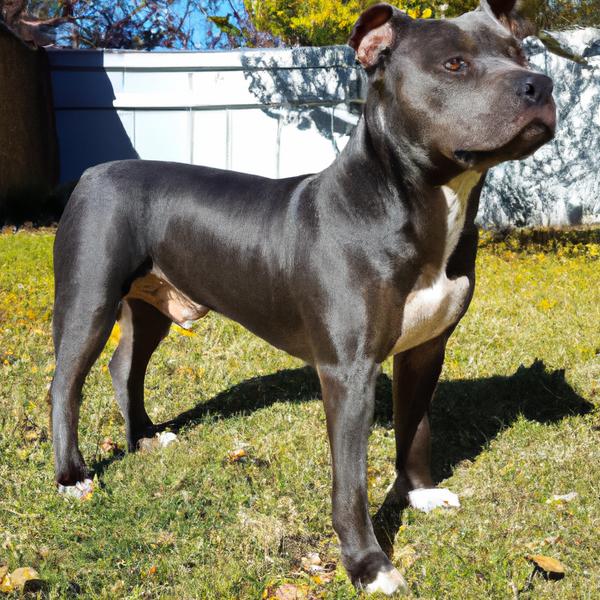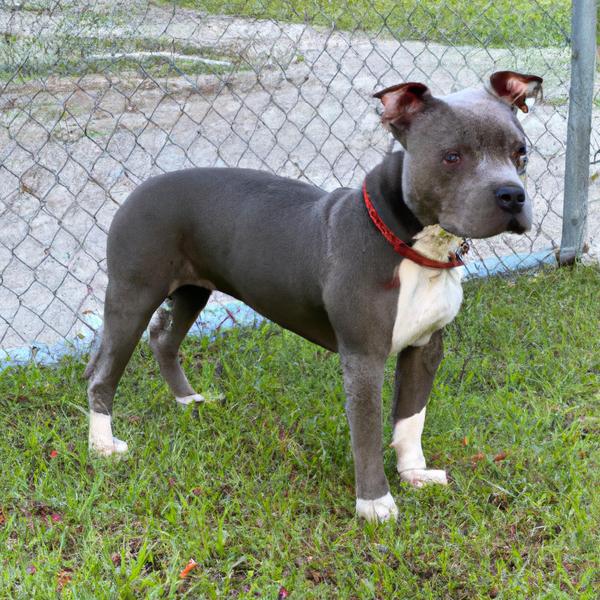Lab-Pointer vs. Pocket Pitbull: Breed Differences and Similarities
Hypoallergenic
Are Lab-Pointers or Pocket Pitbulls hypoallergenic, or neither?
Unfortunately, neither Lab-Pointer nor Pocket Pitbull are hypoallergenic, which may not make them the best choice for dog lovers who suffer from pet allergies.
Temperament
What are the personalities of Lab-Pointer and Pocket Pitbull dogs?
Active
Playful
Loving
Energetic
Alert
Intelligent
Friendly
Responsive
Affectionate
Loyal
Gentle
Going
Social
Outright
Tempered
Kind
Cheerful
Amiable
Stubborn
Clownish
Energetic
Courageous
Intelligent
Confident
Friendly
Affectionate
Obedient
Loyal
Inquisitive
Strong
Willed
Aggressive
Bold
Shedding Level
Do Lab-Pointers shed more than Pocket Pitbulls, or which breed sheds more, Lab-Pointers or Pocket Pitbulls?
Lab-Pointers are low shedding dogs, requiring minimal coat care.
Pocket Pitbulls are moderate shedders, but regular brushing can reduce shedding and maintain coat health.
Watchdog Ability
Which dog breed makes a better watchdog, the Lab-Pointer or Pocket Pitbull?
The Lab-Pointer and Pocket Pitbull dogs are some of the best choices if you want good watchdogs. These breeds will keep watch over you and your family at all times. They take this task seriously and will typically perform their guarding duty with little to no training. These dogs will require obedience training, or you can consider guard dog training to sharpen their skills.
Ancestry
What are the origins of Lab-Pointer and Pocket Pitbull breeds?
Pointer and Labrador Retriever
American Pit Bull Terrier, Patterdale Terrier
Breed recognition
Which kennel clubs recognize/register Lab-Pointer and Pocket Pitbull?
ACHC = American Canine Hybrid Club
DBR = Designer Breed Registry
DDKC = Designer Dogs Kennel Club
DRA = Dog Registry of America, Inc.
DRA = Dog Registry of America, Inc.
Date of Birth
When were Lab-Pointer and Pocket Pitbull breeds first developed?
2000s
Unknown
Eye Color Possibilites
What are the eye colors of Lab-Pointer and Pocket Pitbull dogs?
Hazel
Brown
Amber
Brown
Amber
Nose Color Possibilites
What are the natural nose colors of Lab-Pointer and Pocket Pitbull?
Black
Brown
Isabella
Blue
Black
Brown
Coat Color Possibilites
What are the natural colors of the coat for Lab-Pointer and Pocket Pitbull breeds?
Cream
Brown
Black
Pied
Brindle
White
Gray
Cream
Brown
Black
Coat Length
What is the typical coat length for Lab-Pointer and Pocket Pitbull breeds?
Lab-Pointers have short coats.
Pocket Pitbulls have coats that can be either short or medium in length.
Coat Density
What is the density of the coat of Lab-Pointer and Pocket Pitbull?
Coat Texture
What is the hair texture of Lab-Pointer and Pocket Pitbull?
Straight
Litter Size
What is the usual litter size for Lab-Pointer and Pocket Pitbull?
A Lab-Pointer can have a litter of 5-10 puppies on average. However, it's worth noting that the size of the litters can vary greatly. Factors that can influence litter size include the health of the mother, breeding history, and genetics.
A Pocket Pitbull can have a litter of 5-8 puppies on average. However, it's worth noting that the size of the litters can vary greatly. Factors that can influence litter size include the health of the mother, breeding history, and genetics.
Adaptability
Lab-Pointers are highly adaptable and versatile, making them excellent companions for families and individuals of all lifestyles.
Pocket Pitbulls are known for their adaptability and can adjust well to different environments and lifestyle changes.
Health Issues
Between Lab-Pointer and Pocket Pitbull, which breed is more prone to health problems?
Lab-Pointer and Pocket Pitbull are breeds of dogs that are known to have a higher frequency of health issues compared to other breeds. These issues can range from minor to serious, and regular check-ups with a veterinarian are essential in order to identify and address any potential problems as early as possible.
Major Concerns
What are the major health concerns for Lab-Pointer and Pocket Pitbull breeds?
Elbow Dysplasia
Canine Hip Dysplasia (Chd)
Retinal Dysplasia
Invertebral Disc Disease
Cerebellar Abiotrophy (Ataxia)
Minor Concerns
What minor health issues should be kept in mind when owning Lab-Pointer and Pocket Pitbull?
Entropion
Cataracts
Patellar Luxation
Demodectic Mange
Lens Luxation
Hypothyroidism
Cleft Lip or Palate
Zinc Responsive Dermatosis
Progressive Retinal Atrophy (PRA)
Atopy
Occasional Tests
What occasional tests are recommended for Lab-Pointer and Pocket Pitbull breeds?
X-ray imaging
Blood Analysis
Optical Examination
Orthopedic
Regular Full Physical Examination By Veterinarian
Eye Examination
Skin Evaluation
Electrocardiograph (ECG - measures rate and rhythm)
Myelography (Dye And X-Ray to Assess The Spinal Cord)
Hip and Elbow X-rays
Energy
How do the energy levels of Lab-Pointers and Pocket Pitbulls compare?
Lab-Pointer and Pocket Pitbull breeds are known for their high energy levels, so if you're looking for a more low-key dog, these breeds may not be the best choice.
Social Needs
Lab-Pointer vs Pocket Pitbull social needs comparison
Lab-Pointer and Pocket Pitbull have above average social needs compared to other breeds. They thrive in environments where they have a lot of interaction with humans and other dogs.
Exercise Needed
Lab-Pointer vs Pocket Pitbull exercise need comparison.
The Lab-Pointer and Pocket Pitbull breeds need significant physical activity to maintain a healthy lifestyle. They are well-suited for those who lead an active lifestyle and enjoy activities such as running, hiking, or other outdoor pursuits.
Sleeping Need
Which of the two sleeps the most/least: Lab-Pointer or Pocket Pitbull?
Lab-Pointers are active and require sufficient sleep to stay healthy.
Pocket Pitbulls sleep less than other breeds but still need adequate sleep for good health.
Tendency to Bark
Do Lab-Pointers or Pocket Pitbulls bark more/less frequently?
Compared to most other breeds, Lab-Pointer and Pocket Pitbull tend to be less vocal and bark less frequently. They typically only bark when necessary, such as to communicate or alert their owner, and do not bark excessively, especially when left alone.
Mouthiness
Mouthiness Comparison: Lab-Pointer vs Pocket Pitbull?
Roaming urge
Lab-Pointer vs Labrador: Running away tendency?
Prey Drive
Lab-Pointer or Pocket Pitbull - which breed has a higher level of prey drive?
Past times
What are some enjoyable activities and ways to keep Lab-Pointer and Pocket Pitbull entertained?
Walking, Cuddling, Playing, Fetch and Tug, Fetch, Hikes, Camping, Walk, Run, Road trip, Hike, Tug-of-war, High Five, Dog Parks, Catch treats, Frisbee, Nap
Hiking, Fetch, Cuddle, Adventures, Walk, Sleep, Hike, Car rides, Walks, Snuggle
Activity Level
Which breed has higher energy, Lab-Pointers or Pocket Pitbulls?
Lab-Pointers are high-energy dogs. They need mental as well as physical exercise. These dogs require a lot of your involvement and without it they can, and will, become problematic dogs.
Pocket Pitbulls are medium-energy dogs and typically enjoy socializing and playing casual or even sustained games of chase with other dogs. They may also have occasional periods of barking or racing around the house.
Tolerance of being left alone
Walks per Week
How many miles should Lab-Pointer or Pocket Pitbull walk each week?
There's really no limit to how far you walk your dog as long as they're comfortable. For Lab-Pointer, it's at least 15 miles / week. Just remember to build distance and stamina gradually over time.
There's really no limit to how far you walk your dog as long as they're comfortable. For Pocket Pitbull, it's at least 9 miles / week. Just remember to build distance and stamina gradually over time.
Activity per Day
Do Lab-Pointers or Pocket Pitbulls require more exercise?
In general most Lab-Pointers usually need at least 75 minutes of exercise daily. This can be spread across the day and include all sorts of high-energy activities, like walking, running and playing.
In general most Pocket Pitbulls usually need at least 60 minutes of exercise daily. This can be spread across the day and include all sorts of high-energy activities, like walking, running and playing.
Grooming
Which breed is easier to maintain in terms of grooming, Lab-Pointers or Pocket Pitbulls?
The Lab-Pointer is a low-maintenance breed that doesn't require much grooming.
The Pocket Pitbull has low grooming needs and is easy to maintain.
Brushing Frequency
What is the recommended brushing frequency for Lab-Pointer and Pocket Pitbull dogs?
In general Lab-Pointer should be brushed at least once a month. Of course you can give them more frequent brushes, especially if they enjoyed it
Pocket Pitbull should be brushed at least once a week. Of course you can give them more frequent brushes if you find that they are still shedding a lot
Brushing Tools
What brushing tools are used for Lab-Pointers and Pocket Pitbulls?
Slicker Brush
Flea Comb
Deshedder
Nail Clipper
Slicker Brush
Nail Clipper
Cups
How much food should be given to Lab-Pointer or Pocket Pitbull in cups?
For an average 55-80 pound (25 - 36 kg) Lab-Pointer feed 3 cups daily. But, keep in mind, the amount you feed is going to be dependent on the quality of the food you are feeding.
For an average 30-50 pound (14 - 23 kg) Pocket Pitbull feed 2.5 cups daily. But, keep in mind, the amount you feed is going to be dependent on the quality of the food you are feeding.
Daily Cost
Which breed has a higher daily cost, Lab-Pointer or Pocket Pitbull?
The average cost of a Lab-Pointer is somewhere $2.50 - $2.70 per day.
The average cost of a Pocket Pitbull is somewhere $1.70 - $2.00 per day.
Monthly Cost
Which breed has a higher monthly cost, Lab-Pointer or Pocket Pitbull?
The average per month expenses of a Lab-Pointer is between $56 - $70. This makes an average of $672 - $840 per year. It will be on the higher side when the dog is still small because it will need more frequent visits to the vet, shots.
The average per month expenses of a Pocket Pitbull is between $48 - $63. This makes an average of $576 - $756 per year. It will be on the higher side when the dog is still small because it will need more frequent visits to the vet, shots.
Intelligence
Comparing Intelligence: Lab-Pointers vs Pocket Pitbulls
The Lab-Pointer and Pocket Pitbull breeds are considered very intelligent and easy to train.
Sensitivity Level
How do Lab-Pointer and Pocket Pitbull compare in sensitivity?
This breed is sensitive and requires gentle handling and a calm home environment.
This breed is sensitive to its environment and best suited for patient and understanding families with a consistent routine.
Affection Dependance
Which is the more affectionate dog breed: Lab-Pointer vs Pocket Pitbull?
Apartment Friendly
Which breed is more apartment-friendly: Lab-Pointer or Pocket Pitbull?
It's not recommended to keep Lab-Pointer or Pocket Pitbull in an apartment, but these breeds make good apartment dogs as long as they get to spend a good amount of time outside of the apartment. Dogs of these breeds living in apartments will need plenty of physical exercise and stimulation throughout the day to remain happy and well-behaved.
Child Friendly
Do Lab-Pointers or Pocket Pitbulls have a friendlier temperament towards children?
Lab-Pointers make excellent family pets for kids due to their gentle, protective nature and calm temperament.
Pocket Pitbulls are good with kids if socialized and trained from a young age.
Senior-friendly
Which dog is more suitable as a pet for the elderly - Lab-Pointer or Pocket Pitbull?
Cat Friendly
Do Lab-Pointer or Pocket Pitbull breeds have a better compatibility with cats?
Lab-Pointers are average in their friendliness toward cats and tend to do well with them, especially if raised together.
Pocket Pitbulls are somewhat cat friendly and can be trained to get along with cats.
Dog Friendly
Which breed is more sociable with other dogs: Lab-Pointer or Pocket Pitbull?
Lab-Pointers are generally very friendly towards other dogs, with a happy and affectionate temperament.
Pocket Pitbulls are less friendly towards other dogs, but can improve with socialization.
Pet friendly
How do Lab-Pointer or Pocket Pitbull dogs interact with other pets?
Stranger Friendly
Which breed is more friendly with strangers: Lab-Pointer or Pocket Pitbull?
Lab-Pointers are friendly but may bark at strangers, and training is easy due to their intelligence.
Pocket Pitbulls are averagely friendly around strangers but benefit from early socialisation.
Playfulness
Which breed is more playful between Lab-Pointer and Pocket Pitbull?
Lab-Pointers are very playful, so adopting an older one might be a better option for a more relaxed experience.
Pocket Pitbulls are a playful breed that needs daily playtime to be happy.
Trainability
How do the trainability levels of Lab-Pointers and Pocket Pitbulls compare?
The Lab-Pointer is highly intelligent and eager to please, making it a great choice for both novice and experienced dog owners due to its easy trainability.
Pocket Pitbulls are usually easy to train but require consistency to fully obey commands.
Compare Lab-Pointer with other breeds

Chug
Lab-Pointer vs Chug

Bully Basset
Lab-Pointer vs Bully Basset

Bullypit
Lab-Pointer vs Bullypit

Powderpap
Lab-Pointer vs Powderpap

Schnu
Lab-Pointer vs Schnu

Sprocker Spaniel
Lab-Pointer vs Sprocker Spaniel

Austrian Pinscher
Lab-Pointer vs Austrian Pinscher

Sheltie Pin
Lab-Pointer vs Sheltie Pin

Papijack
Lab-Pointer vs Papijack

Mountain Mastiff
Lab-Pointer vs Mountain Mastiff

Plott Hound
Lab-Pointer vs Plott Hound

Rus-A-Pei
Lab-Pointer vs Rus-A-Pei

